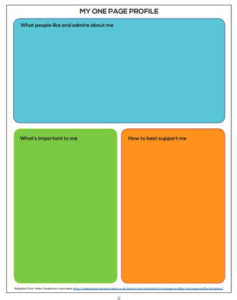It’s More than Just Pictures
Although there are many different types of portfolios, parents of students with disabilities find that “Student-Introduction” Portfolios are an effective communication tool. The purpose of this type of portfolio is to assist others in getting to know the student for who he or she is and not just for his or her disability. School personnel often only have access to very traditional special education records – eligibility documentation, IEP goals and objectives, modifications and therapy reports. These types of records do not always give a full and complete picture of the child. Things to include in a Portfolio may include:
- Table of Contents (if it is more than 8 pages long)
- Student Specific Information (What makes hi/her unique; their loves, interests, & hobbies; educational history; family information; work samples; or letters from families, friends, teachers, peers)
- Pertinent educational records (modifications, specific IEP pages, etc)
- Articles pertaining to specific medical, health or educational information
- Helpful hints on using equipment (communication, positioning, mobility)
- Recommended reading list
In addition to traditional Student Introduction Portfolios, another tool to share important information in an “at-a-glance” format is called a “One Page Profile or One Page Description”. It can help others understand what to pay attention to and what works best to create positive change for the person. One page description document:
- What people like & admire about your child
- What’s important to your child
- How to best support your child
Why Are You Creating The Portfolio or One Page Description?
This question is actually your first step. It is critical that you take the time to really consider your reasons for putting in all the work that it will take to make a dynamic portfolio. Perhaps your child is transitioning to a new school or program and you want the staff to really know who she is. If this is your purpose, then all information you include in the portfolio should be directly related to this purpose. Consider including a “statement of purpose” as the first page of the portfolio. This will help teachers and other service providers understand what they are reading and why it is so important.
Involve Your Child!
Involve your child from the very beginning, regardless of his or her age. If you plan on your child self-advocating in the future, then now is the time to start. Some children may simply enjoy selecting a piece of their artwork to adorn the cover. Others may want to have more input, such as creating the layout for the page that describes their interests and hobbies. At the very least, most children enjoy looking at photographs and can identify a favorite or two to include.
Does Your Family Have A Vision?
Whether you have written it down or not, you have a vision. You may not call it a vision, but you have undoubtedly thought about how you would like to see your child live and interact in this world. Sharing your vision with others will help clearly communicate your expectations, hopes and dreams. We have included one family’s vision in this guide. You may modify it to meet your family’s needs. Don’t know where to start? See Creating A Vision for the Future
What do You Want Others to Know About Your Child?
When others read this portfolio, what do you want them to learn about your child? What new insights, thoughts and considerations do you hope will float through their mind as they read? For one family they simply wanted others to see Alex as “a little boy” – not the long list of disabilities. Alex’s mother included photos of Alex sitting on his grandmother’s lap reading a book and playing a board game with his brother. This may not seem significant to most families, but Alex uses a wheelchair and has many pieces of adaptive equipment that follow him wherever he goes. His teachers were so focused on meeting his educational and medical needs that they didn’t always see the six-year old boy. A few photographs and stories reminded everyone that they were teaching ALEX, not a disability.
Who is the Audience?
Some parents have referred to the portfolio as a “marketing tool”. Every good marketing campaign identifies the target audience and includes images and information to which the audience can relate. The audience for your child’s portfolio may include teachers, administrators, related service providers, classmates, nurse, cafeteria workers, bus driver, IEP team members, Sunday school teachers and daycare providers. Therefore, if your audience will primarily be middle school teachers, include images and information related to middle school, such as participation in school activities and working with peers. Middle school teachers may not be interested in how your child plays during recess, but they may be interested in how your child functions in unstructured, open activities.
How Will You Share the Portfolio with Others?
Determine how to share the portfolio with the intended audience and make plans to include your child. There are so many options – schedule a staffing or meeting and present the portfolio to the whole team; circulate the portfolio among the teachers and therapists; or meet with key staff during their conference time. Have your son or daughter share a few pages at the beginning of an IEP meeting. No matter which method you choose, remember that teachers and other staff are busy, busy people and will appreciate the information being concise and relevant.
IMPORTANT NOTE!!!
Do NOT include important identifying information about your child (ie Dates of birth, social security or Medicaid numbers, etc.)
Protect your child’s privacy. Remember to share only information your child is OK with being shared.
Resources

Charting The LifeCourse One Page Profiles/Portfolios
Sample Portfolio Pages (pdf)
Region 13 ESC – Making an ”All About Me” Book (video)
Helpful Apps:
Story Creator: Easy Storybook Maker for Kids (ios app)
Video Storytelling Projects made with Microsoft Photo Story
Portfolios for Work, Independence:
Rural Institute of Montana – Representational Portfolios
™ Portfolios




